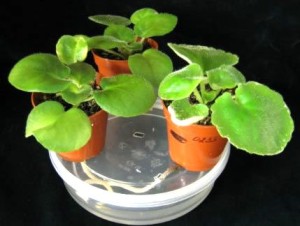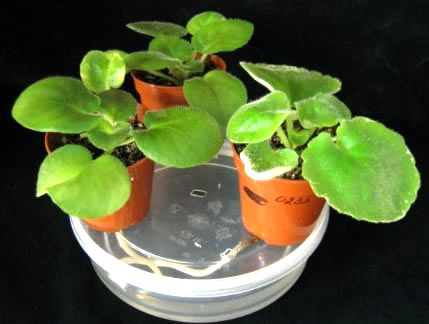The pros and cons of wick watering
 The wick watering system – a method of watering African violets, through which the capillary capacities of the wick are put into operation. The water in the tank rises through the wick and moistens the soil mixture in the pots. As soon as the soil mixture has dried, the water is again 'absorbed'. As a result, the plant obtains the required amount of water at a given time and under the given conditions (heat, cold, air humidity has increased/decreased etc.).
The wick watering system – a method of watering African violets, through which the capillary capacities of the wick are put into operation. The water in the tank rises through the wick and moistens the soil mixture in the pots. As soon as the soil mixture has dried, the water is again 'absorbed'. As a result, the plant obtains the required amount of water at a given time and under the given conditions (heat, cold, air humidity has increased/decreased etc.).
The existing minuses:
1. If the wick is not made of the necessary material and placed correctly in the counters, the mixture of earth can be too wet, the roots of the plant in this case will rot.
2. Over-watering of the soil creates an environment conducive to the multiplication of sciarides.
3. African violets grow in size, if they are watered by wick. This can happen if chickens of African violets are planted in pots with a diameter of 10-12 cm. Chickens of African violet will feel more comfortable and will bloom in abundance, if for the beginning they will be planted in smaller pots, with a diameter of 5.5-8 cm. Dimensions of rosettes, in this case they will develop normally.
4. If the violet tank is located on the windowsill in the cold season, the water in the tank cools down quickly. Regardless of the way of watering, it is recommended to heat the windowsill, or African violets to be moved to a warmer place in the cold period.
If the wick watering system is applied correctly, the pluses are:
1. African violets grow and develop in favorable conditions, without being stressed by over-watering or drying the potted soil.
2. The optimal concentration of the nutrient solutions in the tank allows the plant to feed properly.
3. Potted soil moisture is not checked every day.
4. Winter, due to low humidity of the air, the layer of soil above dries, and inside the pot is kept moisture, the water being absorbed through the wick as much as necessary.
5. African violets can be left without supervision for a long time (a few weeks), e.g.. During the holidays, we will not be stressed that violets are not watered in time.
6. The collection of violets can include a large number of copies without watering each pot separately.
7. In the case of multiplication of African violets by leaves, the evaporation of the water from the container will be kept under control ( a useful thing in the case of a large collection).
8. African violets will bloom lushly and much faster;
9. If the humidity of the air around the African violets is high, they develop harmoniously. From the tank with water, the water evaporates continuously, and the humidity of the air around the plant is maintained within the allowable limits.
10. Watering by wick is ideal for miniature violets that are planted in pots of small size. They can dry out in one day, in the case of ordinary watering.
11. Since the nutrients will reach the plant from the water not from the soil, the pot in which the violet is planted must be small in size (1/3 of the diameter of the plant's rosette). In this case, savings are made in terms of the amount of soil needed to plant violets and the cost of pots ( the larger the diameter, the more expensive they are).
12. A small diameter of the pot allows the plant to develop normally. All the nutrients help the plant more to bloom, than to increase in size.
13. Applying this method correctly, African violets will be healthier, will develop and grow better, will bloom abundantly. The plant obtains the necessary microelements from the nutrient solutions in the tank and regulates the soil moisture.

